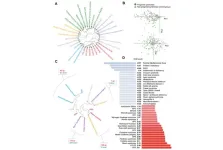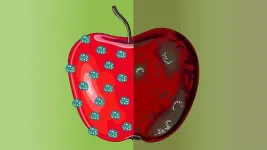(Press-News.org) Researchers at the Pritzker School of Molecular Engineering and the Department of Chemistry at the University of Chicago have engineered tiny, spinning micro-robots that bind to immune cells to probe their function. The robot, or “hexapod,” gives scientists a new, highly adaptable way to study immune cells and to aid in the design of immunotherapies against cancer, infection, or autoimmune diseases.
Each hexapod robot has six arms containing molecules that might be recognized as foreign by the immune system — such as protein fragments from a tumor, virus, or bacterium. Researchers can use the hexapods to scan large collections of immune cells and discover which immune cells bind the foreign molecules of interest and how the hexapods’ movements impact that binding.
“Numerous aspects of which immune cells and how immune molecules sense pathogens remain uncharted territory, and now we have this new tool to help us understand the molecular interactions,” said Jun Huang, associate professor of molecular engineering at Pritzker Molecular Engineering and co-senior author of the new paper, published in Nature Methods.
“Scientists often use biomaterials to study and manipulate the immune system, but we’ve developed a way to use inorganic materials, which is an incredibly unexplored area,” said Bozhi Tian, professor of chemistry and the other co-senior author. “The benefit of these materials is that we can change their properties in many more ways.”
A “T cell” in a haystack
T cells are a type of white blood cell responsible for recognizing foreign pathogens that have been processed by dendritic cells — immune cells with long branching arms that capture pathogens and display bits of the pathogens’ molecules on their surface. There are trillions of distinct T cells in a person’s body, each one with a different T cell receptor that is finely tuned to recognize a pathogenic molecule (antigen) on a dendritic cell.
Researchers who want to boost the immune system’s power to fight a particular antigen often want to know what T cell recognizes that pathogen. But finding the exact match among the trillions of T cells is like finding a needle in a haystack.
“People have developed ways to do this, but they mostly rely on whether a T cell receptor binds an antigen,” said Xiaodan Huang, one of the co-first authors of the paper. “Since some T cell receptors can bind to an antigen without then provoking a strong immune response in the cell, we knew this wasn’t a perfect proxy.”
Previous platforms to study T cells also couldn’t mimic the role of physical force in the interaction between dendritic cells and T cell receptors; they generally relied on isolated antigens that don’t behave like a living dendritic cell.
A robotic dendritic cell
To overcome these challenges, the researchers designed a minuscule robotic mimic for a dendritic cell. The bot has a central, spinning magnetic core and six arms made of silicon dioxide (the compound that most sand is composed of) to which antigens can be attached.
Tian and Huang’s lab groups used known antigen-T cell receptor pairs to test the effectiveness of the hexapod. They put copies of the antigen on all six legs and then immersed the hexapod in mixtures of T cells. Even when the matching T cell was present in small quantities amidst many other T cells, the hexapods bound only the correct cell.
“We were incredibly happy with how well the system worked,” said Lingyuan Meng, one of the co-first authors of the paper. “The fact that it could pick out the right T cells with such a high accuracy exceeded our expectations.”
In addition, the research team showed that they could analyze the resulting immune response in the T cells that bound to the hexapod. For instance, when two different T cells bound to the hexapod, they could determine which led to stronger immune activity. The group also found that the force exerted by the spinning hexapod led to stronger immune responses than when the same T cells bound to static antigens.
“We’d now like to begin applying this to other antigens, including those from human cancers and pathogens,” said Huang. “There are a lot of questions, both basic scientific questions and clinically relevant ones, that can be explored using these hexapods.”
For instance, the hexapods could be used to identify the T cells that most strongly react to certain antigens.
END
Spinning, magnetic micro-robots help researchers probe immune cell recognition
2024-02-21
ELSE PRESS RELEASES FROM THIS DATE:
Helping patients with low income overcome eating disorders
2024-02-21
Individuals with eating disorders who have low income are frequently misdiagnosed and lack adequate access to appropriate therapy, according to researchers from Weill Cornell Medicine and Columbia University Vagelos College of Physicians and Surgeons.
Their paper, published in The Cognitive Behaviour Therapist on Feb. 19, identified the barriers to care that come with having low income and offered guidelines on how therapists can make accommodations for these patients to improve diagnoses and access to treatment.
Approximately 30 million people in the United States experience ...
Preventing relapse by restoring an opioid-weakened brain pathway governing behavior
2024-02-21
Medical University of South Carolina scientists report in Neuron that they have uncovered a way to restore an opioid-weakened brain pathway in a preclinical model.
With funding from the National Institute on Drug Abuse, part of the National Institutes of Health, the MUSC research team, led by neuroscientist James Otis, Ph.D., used advanced neuroscience tools to return a pathway between the thalamus and basal ganglia to healthy functioning in mice. As a result, this restoration prevented mice that were opioid-dependent from seeking or self-administering heroin. Results also suggested that sustained opioid use was the cause of this weakened pathway, rather than being caused by ...
Water quality monitor, locust-inspired electronic nose under development
2024-02-21
By Beth Miller
Two teams of engineers led by faculty in the McKelvey School of Engineering at Washington University in St. Louis will work toward developing products to monitor drinking water quality and to detect explosives with an electronic nose with one-year, $650,000 Convergence Accelerator Phase 1 grants from the National Science Foundation (NSF).
Barani Raman, professor of biomedical engineering, and Daniel Giammar, the Walter E. Browne Professor of Environmental Engineering, will lead teams of researchers from Washington University and other institutions and entities funded under the NSF’s Convergence Accelerator program, designed to address national-scale ...
Child tax credits provided significant relief to families experiencing economic shocks during COVID
2024-02-21
Contact:
Jillian McKoy, jpmckoy@bu.edu
Michael Saunders, msaunder@bu.edu
##
As a proposal to reinstate expanded Child Tax Credits (CTC) in the United States awaits a vote in the Senate, a new study led by Boston University School of Public Health (BUSPH) researchers reveals that the now-expired 2021 CTC expansion benefitted families experiencing financial setbacks due to health or employment challenges spurred by the COVID-19 pandemic.
Published in the journal Health Affairs Scholar, the study found that monthly advance payments included in the 2021 CTC ...
Plasma scientists develop computer programs that could reduce the cost of microchips and stimulate American manufacturing
2024-02-21
Fashioned from the same element found in sand and covered by intricate patterns, microchips power smartphones, augment appliances and aid the operation of cars and airplanes. Now, scientists at the U.S. Department of Energy’s (DOE) Princeton Plasma Physics Laboratory (PPPL) are developing computer simulation codes that will outperform current simulation techniques and aid the production of microchips using plasma, the electrically charged state of matter also used in fusion research. These codes could help increase the efficiency of the manufacturing process and potentially stimulate ...
Novel combination therapy offers promising results for treatment-refractory hepatoblastoma
2024-02-21
Hepatoblastoma (HB) is the most common liver cancer in children. Researchers and physicians in the field are concerned because in the last decade HB has been rising rapidly worldwide and has seen the most rapid increase among all pediatric solid tumors.
A team led by researchers at Baylor College of Medicine has been working on improving therapies for this devastating disease. They recently reported in the Journal of Hepatology a novel treatment strategy that produced encouraging results in animal models.
“High-risk disease leads to high rates of relapse and mortality,” said first author Dr. Andrés F. Espinoza, general ...
New study: Defining the progeria phenome
2024-02-21
“In sum, we have defined what a premature aging disease is and developed tools to allow diagnostics of patients and disease population.”
BUFFALO, NY- February 20, 2024 – A new research paper was published in Aging (listed by MEDLINE/PubMed as "Aging (Albany NY)" and "Aging-US" by Web of Science) Volume 16, Issue 3, entitled, “Defining the progeria phenome.”
Progeroid disorders are a heterogenous group of rare and complex hereditary syndromes presenting with pleiotropic phenotypes associated with normal aging. Due to the ...
Low oxygen in lakes may breathe new life into conservation efforts for water quality
2024-02-21
Abigail Lewis traveled all across the United States for college and graduate school, and she ended up researching lakes in her own hometown.
For one of her graduate research projects, Lewis analyzed 656 lakes across five continents with an international research team. The lakes in her hometown of Waukesha, Wisconsin, were among those included.
“To look back and pull together these two parts of my life has been really satisfying,” said Lewis, who will earn her Ph.D. in biological sciences this spring.
In a paper recently published in Global Change Biology, ...
Engineering a coating for disease-free produce
2024-02-21
Dr. Mustafa Akbulut, professor of chemical engineering, has teamed up with horticultural science professor Luis Cisneros-Zevallos to engineer longer-lasting, bacteria-free produce.
According to Akbulut’s recent publication in Current Research in Food Science, the global fruit and vegetable market loses over 50% of agricultural fruit production during various stages of produce handling and post-harvest treatments.
Many fruits and vegetables already have a layer of food-grade wax that is applied for cosmetic reasons and to prevent water loss. Akbulut’s research combines such wax with nano-encapsulated cinnamon-bark ...
Ochsner Children’s Hospital advocates to close the gap in pediatric heart care
2024-02-21
NEW ORLEANS, LA - Ochsner Children's Hospital, ranked among the top hospitals in the nation for pediatric cardiology and congenital heart surgery, is raising awareness of the need for more pediatric-specific heart devices. As the only pediatric heart transplant program in Louisiana and the only program in the state to offer advanced mechanical support options for pediatric cardiology patients, Ochsner Children’s Hospital is committed to advocating for additional medical devices to enhance its high-quality care to pediatric patients ...



